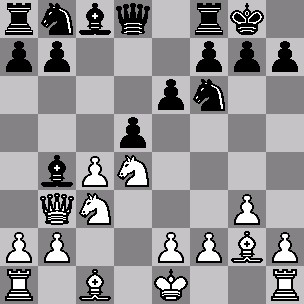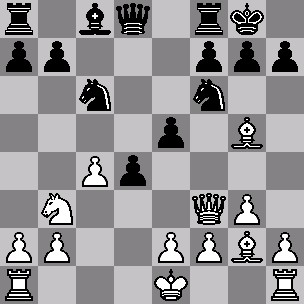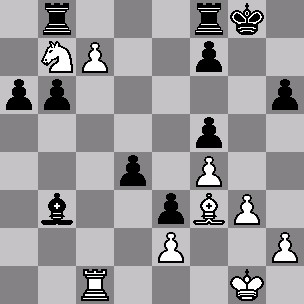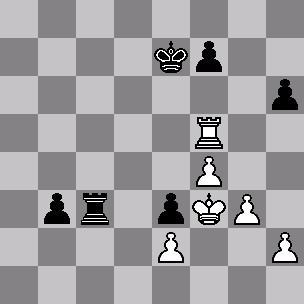27.01.2006
Wijk aan Zee round 11: Ivanchuk-Topalov
Ivanchuk (2729) - Topalov (2801)
Wijk aan Zee Netherlands (11), 27.01.2006
Annotated by Konstantin Sakaev
1.d4 Nf6 2.c4 e6 3.Nc3 Bb4 4.Nf3 c5 5.g3 0-0 6.Bg2 cxd4 7.Nxd4 d5 8.Qb3
A semi-forgotten move that leads to a complex game. According to the theory, Black has good counterchances in this line. The most popular now is 8.cxd5 Nxd5 9.Bd2 or 9.Qb3.
8...Bxc3+ 9.Qxc3 e5 10.Nb3 Nc6 On 10...d4 White has a good reply 11.Qa5!, thus the knight move.
11.Bg5 d4 12.Qf3
Black has more space, but the White's light-squared bishop is very strong, and there are good squares for the knight to jump and bother Black's queenside. In addition, after a number of exchanges on f6, another blow might disturb Black - f2-f4! This is how one of the games in this variation developed: 12...Be6 13.Rc1 Rc8 14.0-0 b6 15.Nd2 h6 16.Bxf6 Qxf6 17.Qxf6 gxf6 18.Ne4 Na5 19.b3, and White only has a minimal advantage, Zhukova,N-Goloshchapov,A/Moscow 2005.
A key game of the B event, Motylev-Carlsen, develops in an exciting way. The variation chosen by Carlsen is well known to me. From human point of view, I think 9...h5 is a mistake. I strongly dislike that the knight is being driven away to h7. Black had to develop his own play with b5 and Bb7, make a prophylactic 9...h6 or consider a pawn sacrifice: 9...d5!? Now White can play in the center and look forward to an easy-to-handle middlegame.
It looks like Anand has an insufficient compensation for a pawn against Tiviakov - a sensation may occur. Their game may continue 14.Qe2 Bxf3 15.Qxf3 Rd8! Black's idea is to meet 16.Rd1 by 16...Rxd1+ 17.Kxd1 Qe6 followed by Qd5.
12...Be6 13.Rc1 Rc8 14.0-0 b6
Leko stands better against Mamedyarov. White presses without any risk. Van Wely equalized or almost equalized against Kamsky. Aronian employed a new idea 15.a5 against Gelfand and stands slightly better. Adams-Bacrot - it looks like Bacrot is very close to equality, I like his plan with Bb7. Karjakin-Sokolov - the game seems to follow both players' home analyses, the position is complex. And Ivanchuk and Topalov still follow the aforementioned game Zhukova-Goloshchapov, which is a model game in this variation.
Anand-Tiviakov. In the position after White's 16th move the game must continue 16...Rxd1+ 17.Kxd1 Qe6 18.Bd4 a6! 19.Re1 Qd5 20.Qc3. White has to struggle for an equality.
15.Nd2 h6 16.Bxf6 Qxf6 17.Qxf6 gxf6 18.Ne4
Tiviakov made a weak 16th move, and now Anand has a good compensation. Leko developed his advantage - he stands clearly better now.
18...f5 Looks fairly risky. Goloshchapov played safer...
19.Nd6 Rc7 White has to choose between 20.c5 with slightly better but double-edged position, or 20.Nb5 Rcc8 21.Nd6 with a draw.
20.Nb5 Rcc8 21.Nd6 Rc7 22.Nb5 Rcc8 23.b3
I think White could fight for the initiative after 20.c5 Ne7 21.cxb6 (weaker is 21.b4 bxc5 22.bxc5 Rb8, Black is OK) 21...Rxc1 22.Rxc1 axb6 23.Rc7 Rd8 24.Nc4 Bxc4 (24...e4 25.Nxb6) 25.Rxc4 e4 26.Kf1, although there is some risk involved. After the text-move Black can play 23...e4 with a good game.
23...e4 Correct. Black has no problems at all, and in addition Vasily goes into a time trouble for some reason...
24.f3 Now 24...a6 25.Nd6 Rcd8 26.c5 Nb4! and Black's just fine.
A very interesting position arose in Leko-Mamedyarov... Motylev won an exchange against Carlsen and has a winning position. If he wins, he leaves Magnus behind and gets into the 1st place. Kamsky-van Wely: it looks balanced, both sides fight for the initiative, but a draw will not surprise me. It looks like Leko still stands better, he should find 23.Qf4. Anand-Tiviakov - Black's position is worse, maybe even losing, and he is in a time trouble as well. Karjakin-Sokolov - White must win.
24...a6 25.Nd6 Rcd8 26.c5 e3 27.f4 Nb4 28.Nb7 Rb8
Bad is 28...Nxa2 29.Nxd8 Rxd8 30.cxb6! Nxc1 31.Rxc1, and the b-pawn is very strong.
Topalov inserted 26...e3 27.f4 in our line. The fact that the b7-knight is protected by the bishop, plays into White's hands, but if Topalov's knight gets to c3, White will face problems with the e2-pawn, which must not be lost.
The position is very complicated. Here is a sample variation: 29.a3 Na2 30.Rc2 Nc3 31.cxb6 Bxb3 32.Rb2 Bc4 33.Re1 Bb5 34.Bf3. Both sides have their trumps. I think Black's chances are at least not worse.
29.c6 Nxa2 30.Bf3 There is logic in White's idea: 30...Nc3 31.Rxc3 dxc3 32.Rc1 with powerful compensation. However, it looks very suspicious to me. Black has extra material and a wide choice of opportunities.
Shak loses to Peter, there is no compensation for the sacrificed exchange. Van Wely risks nothing against Kamsky, and can torture the opponent for some time - White's position is rather unpleasant. Tiviakov makes a draw. And Topalov duly took an exchange - and thinks over his move.
30...Nxc1 31.Rxc1 Bxb3 Veselin grabs everything he can reach...
32.с7
32...Rbe8 33.Nd6 33...Be6 34.Bb7, and here not 34...a5 35.Nxe8 Rxe8 36.c8Q Bxc8 37.Rxc8 Rxc8 38.Bxc8 a4 39.Ba6 a3 40.Bc4, and White gradually wins, but 34...Bc8 35.Nxc8 Rxc8 36.Bxa6 Rfe8 - White achieves a draw with accurate play.
33...Be6 34.Bb7 Bc8 35.Nxc8 Rxc8 36.Bxa6 Rfe8 37.Bxc8 Rxc8 38.Kg2 b5 39.Kf3 This looks like a draw.
39...b4? 39...Kg7 would have drawn the game at once. Topalov tries playing for a win.
40.Rc4 Ivanchuk had a drawing continuation as well: 40.Rb1 Rxc7 41.Rxb4 Rd7 42.Rb5, and a draw. The textmove reveals his aggressive intentions; both players desire to win.
40...b3 41.Rxd4 Rxc7 42.Rb4 Rc3 43.Rb5 Kf8 44.Rxf5 Ke7 And still, this sharp position objectively leads to a draw - but nobody's play is perfect... and it is Black who risks in this endgame.
45.g4 (Alejandro, there is no difference between this and 45.Rb5 - just a move transposition, White does not benefit from K on e4) 45...Kd6 46.Rb5 Kc6 47.Rb8 Kd5 48.h4 48.g5!? deserved consideration, preventing f7-f6.
48...f6 48...Kd4 49.g5 h5 (49...hxg5 50.fxg5) 50.Rb4+ Kc5 51.Rb7 Kc6 52.Rb8 Kd5 53.f5 - White has winning chances.
49.h5 49.g5 fxg5 50.fxg5 hxg5 51.h5! (51.hxg5 Ke6=) - the position is probably drawn, but some accuracy is required.
49...Kd4 Now 50.Rb4+ Kc5 51.Rb7 Kd4= is possible. Ivanchuk probably overlooked that 50.g5 also yields nothing 50...fxg5 51.fxg5 Rc5!=.
50.Rb4+ Kc5 Loek van Wely demonstrates wonders of technique. He lost all winning chances and might have problems drawing... Oh, computer gives mate in 8 starting with 49.Qd6+! Kamsky efficiently handles a queen - he defeated Gelfand and now wins against van Wely.
51.Rb7 Kd5 52.g5 fxg5 53.fxg5 hxg5 (53...Kc6! 54.Rb4 (54.Rb8 Kc7) 54...Rc5=) 54.Rb8 Now 54...g4+! secures a draw: 55.Kxg4 Rc2 56.Kf3 (56.h6 Rxe2 57.h7 Rh2=) 56...b2 57.h6 (57.Ke3 Kc4=) 57...Rc6=.
54...Rc4 55.Rxb3 Ke5 56.Rxe3+ Kf5 57.Kg2 The simplest way to achieve a draw is 57...Rg4+ 58.Rg3 (58.Kh2 Rh4+ 59.Rh3 Re4=) 58...Re4 59.e3 g4.
57...Rg4+ 58.Rg3 Re4 59.Kf2 Rh4 60.Rf3+ Ke5 61.Re3+ Kf5 62.Rf3+
Game drawn. ½-½
A highly tense struggle in what was initially a drawn rook endgame. I think Ivanchuk was never at risk, but a single inaccuracy could cost Topalov dearly, and yet the Bulgarian pressed to win. Tomorrow join us to observe a battle between the leaders! See you soon!







